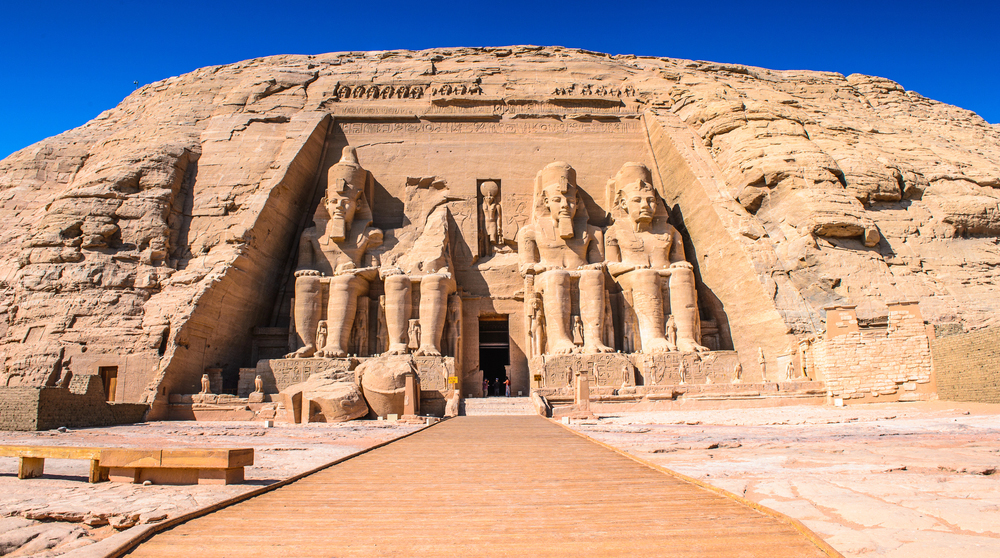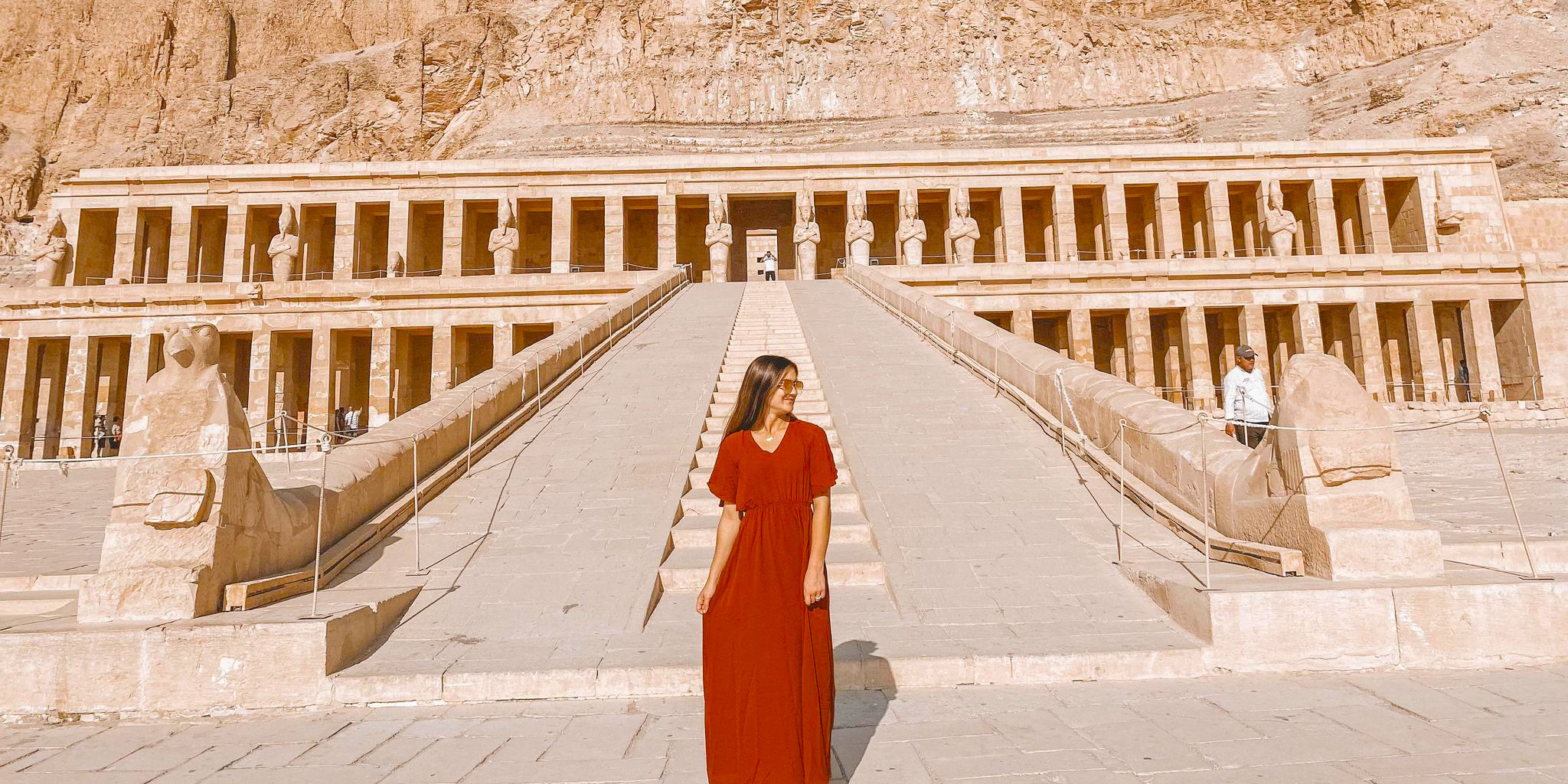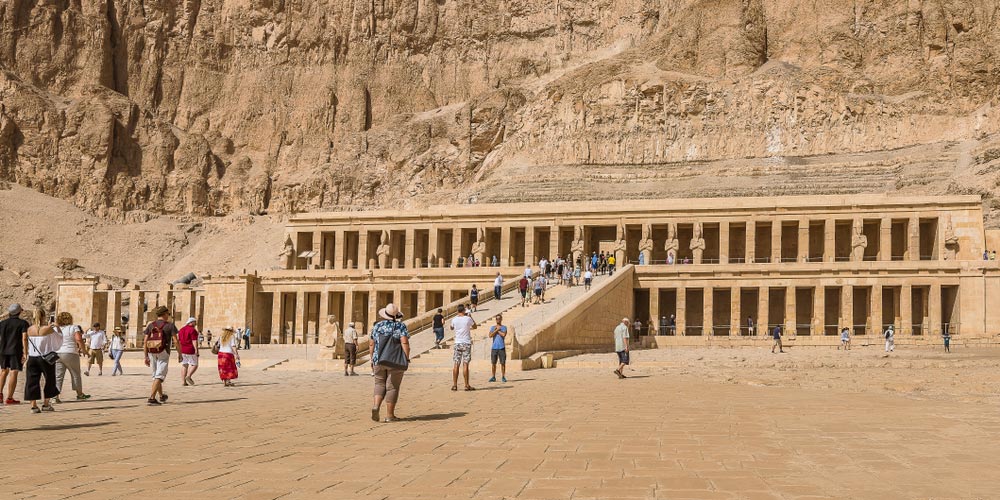Seems like the kings of ancient Egypt desired to construct a stairway to heaven where they can catch the stars with their own bare hands and join the gods in their rightful place and so the great pyramid was born so they ended up building the Great Pyramid. Khufu Pyramid was a true representation of the structure of Egyptian society and it also bears a religious significance.
The pyramid was a replica of the primeval mound where the universe was created by Amun. It’s no surprise that the pyramid was selected as one of the ancient world’s seven wonders; the last sound and unscathed wonder. The Great Pyramid was given numerous credits for the huge accomplishments it has been the very reason for. Not to mention the fame it acquired as one powerful structure built by the 4th Dynasty King Khufu; one of the mightiest pharaohs ever!!

The Pyramid of Khufu Location
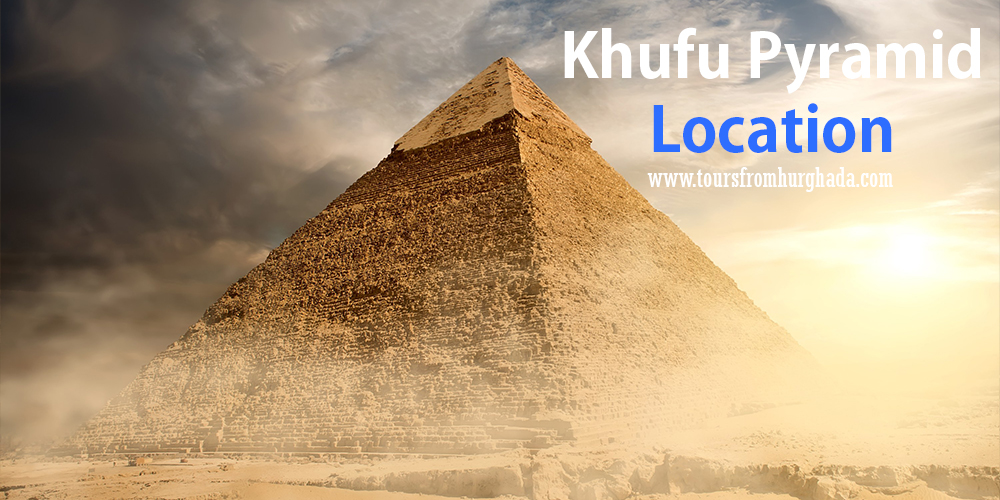
Khufu Pyramid is located in Al Haram within Nazlet El-Semman, in El Giza Desert as a part of the Giza Governorate. It’s nestled in Giza in the famous Giza Pyramids Complex on the Nile Bank at the exact intersection of the longest line of latitude and longitude. It’s situated in the same space as the other two great pyramids and one Great Sphinx that, together, have sworn to send the travelers’ minds reeling!!

Khufu Pyramid History
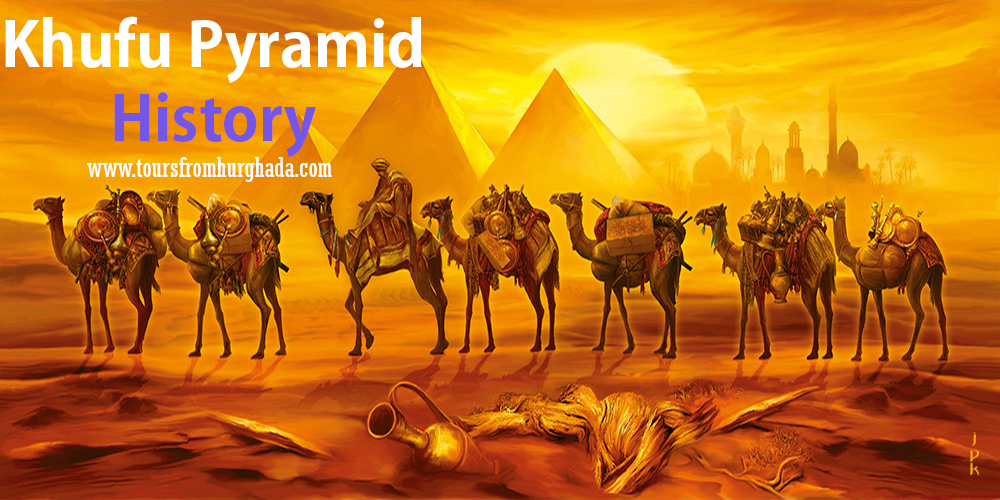
The Pyramid of Khufu was built by Pharaoh Khufu of the Fourth Dynasty around 2560 BC. It carries his tomb and considers his final resting place which made the pyramid one of the most ancient structures in the world dating to more than 4500 years. It is the first of three pyramids built during the Old Kingdom (2686-2181 BC) in a location that became known as the Pyramids Complex in Giza.
Khufu Pyramid became known as “Cheops” because of the Greeks who chronicled their exploration journeys to Egypt many centuries later. The Great Pyramid was once the tallest man-made structure on the globe for more than 3,800 years until the construction of the Lincoln Cathedral, England in 1311.

The Structure & Dimensions of King Khufu Pyramid
The construction method proves how the Khufu Pyramid is a pure example of an accurate architectural skill and a reminder of the powerful might and will of the ancient Egyptians. The pyramid sides rise at an angle of 51°52′ and are oriented to face the four cardinal points of the compass. The pyramid’s building process is one of the longest that history has ever witnessed with about 20 years of construction and was designed by Khufu’s vizier, Heminuu.
The construction demanded the use of around 2.3 million blocks of limestone, each block weighing 2.5 tons. It resulted in a total mass of 5.9 million tons and a total height of 146.7 m (481 ft) on a base of 230.3 (756 ft) long. It was a testimony of the ridiculously creative building skills that the pharaohs were born with anciently.

The Mysteries About How the Great Pyramid Built
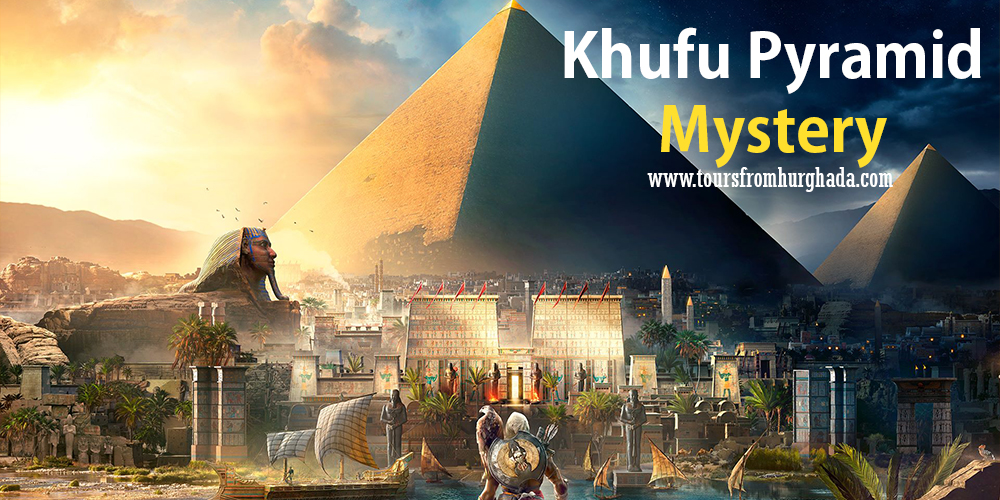
As a center of interest and intrigue among travelers, the Great Pyramid has lots of theories built around it. Theory after another polished the pyramid rank among the other milestones in Egypt, yet, all over the world. And the upcoming passages are different announcements made by a group of pioneer figures about what could be the origin of the pyramid:
-
The Greek Hypotheses of the Khufu Pyramid
There are many hypotheses and theories about Khufu Pyramid but the most prominent one is the Greek theory. It suggests the pyramid was built using slave labor, but it was proven false. As to reach this level of miraculous precision, you need to have a deep understanding of the dynamics of management and critical analysis methods to be able to utilize and control a workforce that peaked at roughly 40,000 skilled workers. This massive labor force was organized by a hierarchy and divided into teams that had wagers and enjoyed many civil rights. And the following are a number of Greek historians and figures each of whom has his own interpretations of the Great Pyramid’s origins with valid and invalid proofs:
-
Herodotus’ Theory about the Great Pyramid
Herodotus’ theory is included among the most outstanding Greek allegations that point out the truths behind the Great Pyramid. He was also the first prominent author ever to build a theory about the Pyramid of Khufu. Herodotus was an ancient Greek historian who wrote a variety of amazing editions. However, he mentioned in the second work of his “The Histories” book some interesting beliefs about the Great Pyramid. Herodotus depicted Khufu as a savage king with a hostile attitude, ordering people around like slaves, never mind exploiting them, which ended up in erecting the insanely towering building of the Great Pyramid. The misconception was so totally invalid since the king hired paid labor, yet it got the travelers to appreciate his majesty’s goldy efforts in building a prosperous part of Egypt even more, trying to eras as many effects as possible that such ridiculous accusations left on the minds.
He elaborated saying a gang of 100,000 hardworking laborers strived over 3-month shifts for two decades to bring such a massive work into existence. He claimed further that the Pyramid of Khafre has a passage at which the Nile flows through an island and leads straight to King Khufu’s cemetery. Herodotus also came up with a description of the outer part of the Great Pyramid which, on behalf of his pioneer interpreters, refers to the garlic, radishes, and anions the founders might have eaten during the building process. Hence, it seemed that the Greek author’s interpreters did not have enough potential to decode the hieroglyphic symbols, or they just chose the easiest way; giving fabricated interpretations.
-
The Theory of Diodorus Siculus about the Khufu Pyramid
Diodorus Siculus was another glorious ancient Greek historian who gave his opinion about the Great Pyramid according to the pieces of evidence he put together. As came in his report that neither Khufu nor Khafre was buried in their pyramids. Instead, he suggests, that the two kings were resting elsewhere fearing the builders will keep the bodies in their control as a means of vengeance, which is a citation for “The slavery” misconception that was previously stated by Herodotus. However, it is safe to say that the ridiculous slavery misconception doesn’t have anything to do with either the life or the death records of the two kings yet doesn’t relate to their majesties’ real glory by any chance.
He also mentioned in his report that the pyramid’s cladding was able to maintain a prime condition back then, while a 6-cubit-heigh podium was what created the uppermost design of the pyramid. He also added in his report that the Great Pyramid was established and supported by a number of ramps since the discovery of hoisting tools wasn’t made just yet. However, his report wasn’t supported by solid and official proof to validate his theories.
-
Strabo’s Theory about the Great Pyramid
Strabo’s beliefs were also included among the Greek-interesting-yet-not-credential theories among architects and Egyptologists. Strabo was a Greek philosopher, geographer, and historian who paid a visit to Egypt after it was conquered by the Romain rulers. He stated in his famed work, “Geographica”, that, located inside the pyramid at a decent height, is a stone with a great possibility it was taken out and instead replaced by an alley leading straight to the tomb.
His statements were ones of controversiality, as according to his allegations, the Great Pyramid was violated before. Turned out that Strabo’s Theory is another belief that gave many people, Egyptology-specialized or not, an existential crisis about the history of ancient Egypt.
-
Pliny the Elder about the Great Pyramid
This time around came the assumptions of Pliny the Elder, a great writer of Roman roots. The writer suggests that building the Pyramid of Khufu was no other than a means to force the commons into an unnecessary, large amount of hard work. He also alleged the Great Pyramid was erected as a way to maintain his powerful position against his opponents and precedents. And he has two possibilities as to how the pyramid managed to hit such massive levels with its towering height and astonishing layout.
One possibility is the heaps of salt and niter might have accumulated around the pyramid and then came the river water to wash them away. The other possibility is the one of constructing bridges. However, said bridges were dismantled into bricks and later, every individual took his fair share to build their own shelters, alleging the water’s flow level doesn’t stand a chance against the pyramid’s hovering height. He also came up with a description of Thales Miletus’ discovery to make the process of measuring the Great Pyramid’s height less hectic by defining the different dimensions of the pyramid’s reflected shadows.
-
The Big Void Theory of the Khufu Pyramid
The Great Pyramid has been the subject of various fringe unorthodox theories over the infinite centuries all because it still contains countless mysteries. In 2017, a team of Japanese researchers and scientists discovered a Big Void above the Grand Gallery at a length of 30m (98 ft) using muon radiography and the purpose of the cavity is still unknown. There are also various theories that try to give alternative reasons and explanations for why the pyramid was built. Some of them are farfetched like Atlantian origin or even alien origin. Which is another theory that fogs a variety of people’s minds and still looming on the “mystery horizon” of the Great Pyramid.
-
The Orion Correlation Theory of the Pyramids
Came among the popular theories that discuss the origin of pyramids is the Orion Correlation Theory. The theory states that the pyramids were an accurate reflection of Orion's belt, Leo's constellation, and the Milky Way and argued that the pyramids might be older than what is believed to be. A great deal of mystery and unanswered questions still surround the pyramids which explain why the pyramids are very attractive to most world travelers.
It’s funny really how the great effort made by different resources to prove their point is met by an amount of fun from travelers and citizens to see who is first to prove more abnormality about the pyramids. However, it is worth mentioning that, those theories are considered an undivided part of the pyramids’ distinctive auras and are appreciated by some people while discarded by others.

Khufu Pyramid Inside
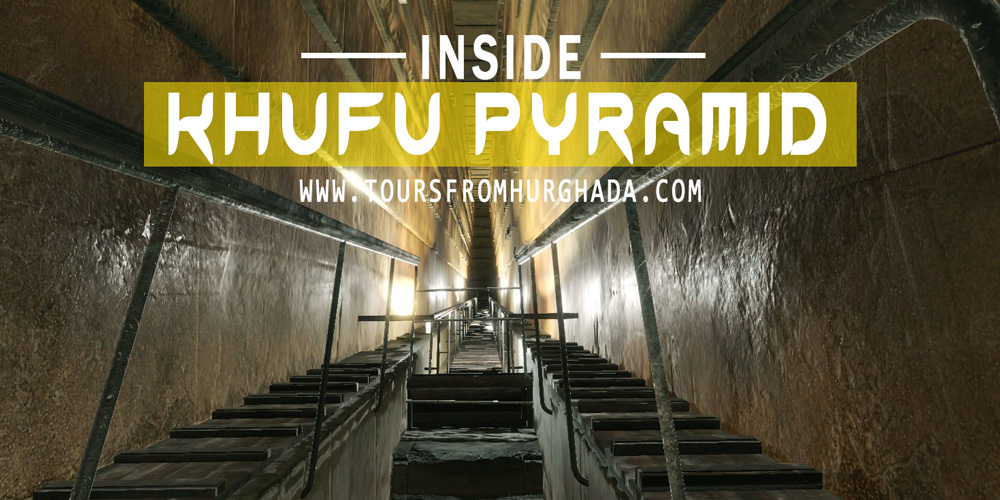
-
The King Chamber is the First Main Part of the Khufu Pyramid
There are three well-known chambers within the great pyramid of Giza. The first chamber is the king’s chamber which is a façade with granite and only holds a rectangular granite sarcophagus. Above the chamber are the five rooms called relieving chambers, and between them is a limestone beam. The purpose of these relieving chambers was to absorb the pressure on the king's great chamber and redirect it into the surrounding stones.
Above the first floor are two narrow shafts with a misconception of appearing to be aligned with certain stars of the northern and southern skies so they help in ascending the king’s spirit & soul to the heavens. It all made the Great Pyramid one, if not the greatest, part of Egypt to be carved in history books with golden letters!!
-
The Queen’s Chamber is the Second Well-known Part of the Khufu Pyramid
The second chamber is the queen's personal chamber, in which the wife of the pharaoh was kept, and contains the same design as the king's chamber with some minor different designs. The chamber nestles in the pyramid midway between the north and the south. It’s 11 cubits in length towards the east-west and 10 cubits towards the north-south with a tapered roof of 12 cubits. At the end of the royal chamber towards the east, lays a 9-cubit niche in height. The niche has an official depth of 2 cubits. However, the niche was dug further at the hand of some treasured holdings’ hunters. The queen chamber is among the pyramid’s parts which also had an underestimated number of valid and fabricated stories built upon its design and value.
-
The Grand Gallery is the Third Famous Part of the Khufu Pyramid
The history of the Great Pyramid’s building also includes establishing a third chamber known as the Grand Gallery which is a passage that provides access to the royal burial chambers. It is exactly 8.6 m (28 ft) high, and 46.68 m (153.1 ft) long. The walls of the gallery are perfectly lined with massive granite blocks corbelled inwards by 2.4–3.9 in on both sides. It also has a slight overhang until the structure meets at the high point, making the grand gallery a little more incredible. There are so doubts the Grand Gallery will add more flavor to your exploration; it’ll make you treasure even the slightest of dust your fingers might run into touching its walls.

Theory about the Great Pyramid Construction

Linking the Great Pyramid with so many grapevines is something the Great Pyramid has earned a long time ago. That’s why there are many theories stating the pyramid was built with the use of very advanced techniques of construction. As Khufu Pyramid was painted over in white limestone, giving it a smooth heavenly look. The remnants of stone blocks were taken, over the centuries, to build fortresses and mosques during the various time period of ancient Egypt.
However, some believe that once the pyramid was completed, a special block made of a shining material like gold or electrum was placed on the top of the pyramid. Still, no matter how many allegations and assumptions trailed behind the Great Pyramid, there are still more others that yearn for dominance. However, the pieces of evidence provided are not that close to proving the validation of those assumptions just yet.

Widespread Misinterpretation of the Great Pyramid
Among the information about the Great Pyramid is a misconception that was spread during the late antique, which was referred to as the “Joseph's granary”. It is a misconception that, little by little, morphed into something more famed. The misconception was delivered from written statements of Egeria, a female pilgrim belonging to the Christian faith. Her statements date back to a trip between 381–384 AD.
According to the statements, there are various pyramids nestled in the stretching 12 miles between Memphis City and Babylonia that worked as corn storage for Joseph. However, a decade later, the statements somehow were proven right by seven priests heading on a trip from Jerusalem to visit Egypt’s most remarkable ascetics. According to their statements, they spotted Joseph's granaries wherein he harvested his grain throughout biblical times.

The Missing Tip of the Great Pyramid

The Great Pyramid is covered on the top by what’s called a pyramidion; the uppermost capstone. The pyramidion was made out of granite and limestone basalt; a mixture that’s still brought into the discussion at any given chance with lots of question marks around it. As some other theories tell that the capstone is made out of solid gold or glided material.
However, pyramids such as the Satellite Pyramid of Khufu and the Red Pyramid, which belong to the Fourth Dynasty, have made-out-of-white limestone pyramidia and were not proven to be glided. Hence, in the Five Dynasty, there were proven the “Made-out-of-glided capstone” theory. As the proof is unfolded in a famous sight of Sahure’s causeway with its white golden capstone.

Khufu Pyramid Complex
The complex of the Great Pyramid is full of minor sites that’ll unveil even more mysteries for you and lock your mind even deeper into the pyramid’s history. The pyramid has a temple whose largest part was vanished with just remnants of black basalt still holding on. It also has a burial site that belongs to Queen Hetepheres I, who was King Khufu’s mother and Sneferu’s sister-wife. The cemetery lies at an estimated distance of 11 meters further toward the east of the Great Pyramid. Included also as a part of the Khufu complex are 4 subsidiary pyramids that can be spotted at the complex’s southern end.
Three of the pyramids still hover over the complex with their height and are commonly referred to as the Queen’s. The complex also hosts three pits taking the form of boats and can be found towards the pyramid’s east. The pits were customized to fit inside complete boats. And as a final inclusion, the Great Pyramid complex has the Pyramid Town which has an interesting story behind it. As there’s once a unique structure surrounding the Giza complex called the Wall of the Crow, a wall made out of cyclopean stone. Then came Mark Lehner with his famous discovery of the “Lost City”; a labor city that extends beyond the wall and dates back to the Khafre and Menkaure eras.

Why King Khufu is Worthy of Admiration
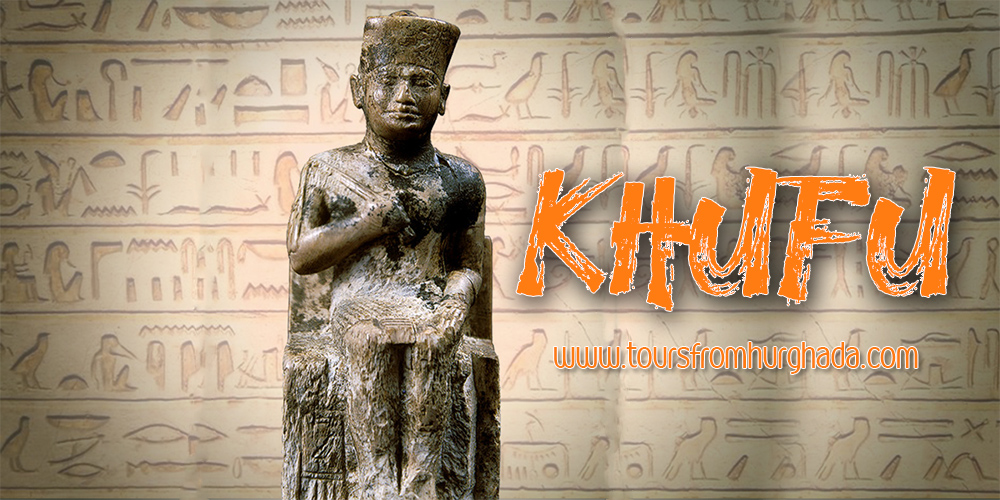
Among the figures that attributed to the welfare of the 4th Dynasty is the Pharaoh Khufu. He was famous for his active trade outside as well as his great gestures in Egypt’s industry. He dealt with genuine substances such as copper, turquoise, and cedar wood, so you would have found him back then walking with a title such as “A prominent, genius pharaoh with a mind of gold” looming over his head.
He also was the ace in the mining field with lots of accomplishments on his plate. It's not a surprise to know his name was included in the inscriptions covering the ancient quarries, such as Wadi Hammamat and Hatnub with alabaster, Basalt, and other of quartz and golden materials. This and more got the pharaoh to leave an extremely unique impression about ancient Egypt and its fortune on the globe.

The Khufu Pyramid Importance in Egypt’s Tourism
If the glory of the Great Pyramid wasn’t enough reason to visit it, then, its terrific surroundings will get the job done. Your visit to the Great Pyramid would be a journey to explore a large part of ancient Egypt’s mysteries step by step. Further, it’s wherein you’ll figure out more about ancient creativity, technology, and the ancient sense of innovation from scratch.
You’ll find travelers visit the Great Pyramid with different intentions in hearts and a variety of thoughts in mind. Some might visit it as the last surviving wonder out of the other ancient world’s wonders. Other people explore the pyramid just to get as close as possible to a grandiose figure like Khufu; one of the aces of his age. Other genres of people visit the pyramid just to validate the numerous facts spoken about its construction and value. All in all, no matter what the purpose of the travelers is, they will always find a way to visit the pyramid and cherish it, which gets tourism in Egypt hit different levels of welfare.

Conclusion
Tours from Hurghada was given birth to by the high levels of willpower to customize every fabulous and new for travelers. The trips and tours we offer since 2004 were brought to life by a womb of glory and prestige. Further, we’ll get you to explore the most magnificent, charming civilization on the planet ever, which the Khufu pyramid is an undeniable part of.
Now brainstorm all the luxurious ideas you have in mind about a trip then look up us to choose the trip you’ve been looking for, overwhelmed by velvet amenities from the elegant accommodation and the pioneer tour guides to the private transition and total safety all in an extraordinary atmosphere!!
From: $300/Per Person
2 Days - 1 Night
2 Days Luxor & Abu Simbel Trip from Hurghada
Enjoy 2 Days Luxor & Abu Simbel Trips from Hurghada joined by a professional Egyptologist tour guide and ...
From: $370/Per Person
2 Days / 1 Night
Overnight Trip to Cairo from Hurghada By Plane
Private overnight trips to Cairo from Hurghada by plane to visit the most famous historical and cultural ...
From: $220/Per Person
2 Days / 1 Night
2 Days Trip From Hurghada to Luxor
A private 2 days trip from Hurghada to visit Luxor temple, Karnak temple, Valley of the Kings, Queen Hats...
From: $370/Per Person
2 Days- 1 Night
Two Days Cairo and Luxor Trip from Hurghada
Enjoy a gorgeous two days Cairo & Luxor trip from Hurghada to visit the best attractions of Pharaohs, the...


